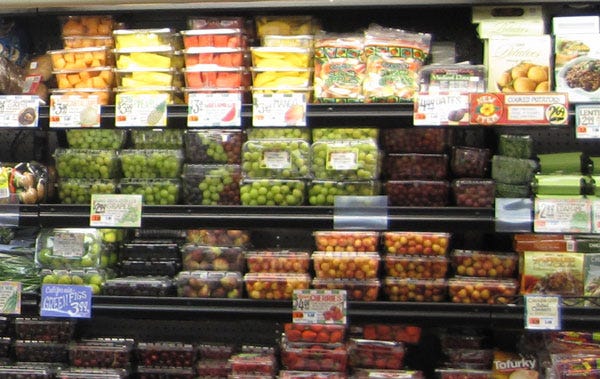Welcome to another edition of Willoughby Hills!
This newsletter explores topics like history, culture, work, urbanism, transportation, travel, agriculture, self-sufficiency, and more.
Sixteen years ago, my wife and I took a trip to the southern part of Germany. It was late winter. The crocuses were just beginning to push up towards the sun and snow flurries fell on us a few times in our week there.
We had rented a Volkswagen Polo and were roadtripping through Bavaria, stopping off in many little small towns along the way. Rothenburg ob der Tauber is a medieval city with its centuries old defensive walls still in tact. We stayed just outside of the walls in a small bed and breakfast that my wife somehow found.
Our host, Karin was an older German woman. She served a large breakfast for the two of us plus another American family that was staying in the home. She had prepared the full meal before we were even awake and it was quite the spread as I recall.
What struck me about the meal was less the actual items on the menu and more the care that had gone into the preparation and sourcing of our breakfast. As we ate, Karin told us about the neighbor with chickens where she had gotten the eggs that morning and her early trip to the bakery for fresh pastries.
Even in the late winter when fresh produce is still sparse, this German woman was buying local food from small growers and producers and doing that practically daily in small doses.
We tended to romanticize Karin and her local breakfast for years to come, holding her up as an example of understanding food, upholding local traditions, and sourcing the best ingredients. We were eating in an old woman’s home, not a Michelin starred restaurant, and yet that breakfast still evokes strong memories all these years later.
Rothenburg is a centuries old city and it’s possible that Karin was still a lone traditionalist who we serendipitously encountered. I’m not sure that Karin’s diet was necessarily representative of the German people as a whole.
While there were plenty of farmers markets and speciality stores selling cured meats and alpine cheeses made the same way for generations, we also stopped in supermarkets that felt very American, selling plenty of heavily processed sodas, candy, cereal, and condiments. (While the formulations in Europe are different than in the U.S., these are hardly “health foods.”)
Through the years, we encountered many other “Karins” in our travels. There was the owner of a vineyard and olive grove in San Gimignano, Italy who had some of the best olive oil I have ever tasted and whose wife cooked us the most delicious pasta lunch. There was the coffee farm we stayed at in Costa Rica where breakfast was served every morning with fresh papaya, pineapple, and whatever other fruits were ripe on the fruit trees that lined the property.
One time years later, we were watching British chef Jamie Oliver teach young teenage apprentices how to cook in his restaurants and a quote stood out. Oliver told the students that his recipes were very simple to make; it was the sourcing of the food that made all the difference. Using the best quality ingredients at the peak of freshness made the food delicious, not complicated or technical preparation styles.
Over time, we have adopted that Jamie Oliver style of cooking ourselves, infused with a dash of Karin’s old world shopping techniques. We were fortunate that our old house in Eastern Massachusetts was nearby to several organic farmers and pastured meat producers that could help supply us with fresh, quality ingredients that blew the grocery store away.
Since moving to Western Massachusetts a few months ago though, we have found that this “locavore” style of eating has been taken to the next level. There is an embarrassing wealth of small organic farms, backyard growers, and local grocers that make eating in season and fresh even easier.
The challenge in eating this way is that it often involves a dispersed model of shopping. We no longer visit the supermarket once a week and stock up for our needs in a half an hour. Rather, acquiring food is a daily effort that involves visiting the best farms and shops for produce, meat, dairy, eggs, and more.
As I discussed with J.B. MacKinnon on a recent podcast episode though, the results are so worth it. The American style of eating often revolves around the belief that everything should be available at all times, but that’s not actually how nature works. It takes a vast amount of technology and transportation to get produce and other goods year round from every corner of the globe.
But when choice is limited to what’s in season, meal prep somehow becomes easier. Instead of an infinite option of foods grown and shipped from around the world, we are limited to a handful of options of what was picked in the last day or two. Meals are built around these small choices: “We have kale, collard greens, and tomatoes right now. What should we do with them?” Rather than “What do you want to eat?” and trying to shop around that.
This topic also came up on my recent podcast with Austin Frerick. That interview largely centered around consolidation in the food industry and how a handful of barons control much of what we eat. But at the end of the conversation, Austin and I discussed ways to combat these trends.
One of his ideas was the reintroduction of home economics to schools. Rather than offer it as a standalone class, Frerick advocated seeing home economics in a more holistic, Montessori model, where learning how to grow and cook food could be tied to other parts of the curriculum: math, history, science, etc.
I think these ideas are spot on. Part of the reason that our food culture in America has become so ultra processed and so consolidated, in my opinion at least, is because we have let it happen. We have stopped learning how to cook, outsourcing every step in the process to companies. Amongst fresh produce now, American supermarkets also sell watermelons and pineapples that have been pre-sliced or onions and peppers that have been pre-chopped.
By learning to cook, we begin to appreciate the role that ingredients play in each dish. We may better recognize the flavor of a fresh, organic, vine-ripened tomato over one grown in Mexico and transported for days in a truck. The latter are bred for hardiness in transit, not flavor.
When we collectively learn again how to taste an egg from a healthy chicken versus one crowded in a dark, indoor barn with thousands of other birds, we may begin demanding changes to what we eat in this country.
As I’ve explored the back roads here in Western Massachusetts, I am always on the lookout for new farms and gaining clues about what they grow from what I can see from the road- is that dairy using jersey cows or holsteins, for example. A few years ago, I would have thought that a cow was just a cow.
We have a long ways to go here in America. If Karin was a rare bird in Germany, she’s practically extinct here in the U.S. But discovering the dozens of local farms that exist within at 20 mile radius of my new house gives me some hope.
If you’re not already, please try cooking tonight. Even something basic. That simple dish may become more complex and more tasty as your skills improve and your tastes develop. Reject the notion that food needs to come from a supermarket and have a UPC code (or cartoon character) printed on it.
Let’s rediscover food together, and in doing so, reclaim our humanity and our place in nature.
Thanks for reading Willoughby Hills! Subscribe for free to receive new posts and support my work.
Related Reading
If you’ve missed past issues of this newsletter, they are available to read here.












I like this, but I also add we need more diners and cafeterias for those who aren’t physically able to cook, so that we balance out eating in season, with honoring our friends and sometimes ourselves who despite a healthy diet, don’t have mobility to cook.